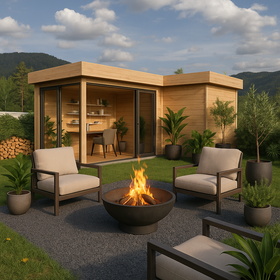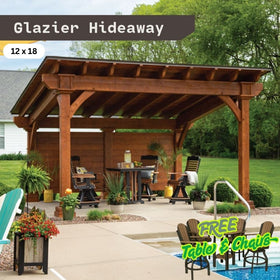512-777-0154

How to Use a Wood Fired Oven?
Ever wondered if a wood-fired oven is good for more than just pizza? Spoiler: It is.
Cooking with fire seems simple enough until you try it. Managing temperatures, perfect timing, not burning your dinner, there’s a learning curve.
But don’t worry. Once you get the basics down, it’s surprisingly straightforward. And, honestly, kind of fun.
In this post, you'll discover exactly how a wood-fired oven works. You’ll learn what tools and materials you need and which ones you don’t.
And because knowing a few extra tricks can save you some serious headaches, you’ll also get cooking tips to help you master everything from crunchy pizzas to perfect artisan bread.
What You’ll Need Before You Fire It Up
Before you toss that first log into your Chicago Brick Oven 500 DIY Kit Wood Fired Pizza Oven, ensure you've covered the essentials.
Here’s what you'll need:
- Seasoned hardwood: Dry, seasoned hardwood burns cleanly and evenly. Avoid treated lumber at all costs—it contains chemicals you don’t want near your food.
- Long-handled tools: Think Chicago Brick Oven 1000 Peel - 12" x 14" Aluminum Pizza Peel, brush, and fire poker. Long handles let you reach deep inside without roasting your knuckles.
- Infrared thermometer (or good instincts): A Chicago Brick Oven Infrared Thermometer Gun is ideal, but after a few uses, you'll know by instinct if your oven is ready. Toss a pinch of flour in; if it browns immediately, you're good.
- Natural fire starters: Skip lighter fluid entirely. Go for chemical-free starters like wax-coated wood curls or natural kindling. They burn clean and won’t ruin your food’s flavor.
- Heat-resistant gloves: Because you only need to touch a hot pizza stone once to understand their importance.

Extras worth having around? A pizza stone for perfectly crisp crusts, cast iron pans for roasting veggies or meats, and metal trays that can handle the heat.
Step-by-Step: How to Use a Wood Fired Pizza Oven
Cooking with fire feels intimidating at first. But once you break it down, it's pretty straightforward. Here’s exactly what to do.
1. Start With Dry Wood and Kindling
Start your fire with small, dry kindling arranged either teepee-style or log cabin-style. Both methods create airflow, helping the flames grow naturally.
Avoid wet wood; it smokes heavily and doesn’t heat properly. Light it up and let it build.
2. Let the Pizza Oven Heat for 30–60 Minutes
Give the Alfresco Grills 30" Pizza Oven Plus - Countertop Model at least half an hour to fully heat. You'll notice the inside walls turning white, a clear sign your oven is nearing the ideal temperature. Wait it out, rushing means uneven cooking later.
3. Test the Heat With an Infrared Thermometer (or Flour)
Infrared thermometers are handy but not essential. Aim for around 700°F (370°C) for pizza, and lower temperatures for bread or roasts. No thermometer? Toss a pinch of flour onto the oven floor. If it turns brown immediately, you’re ready to go. If it smokes instantly, it’s probably too hot.
Related: How To Use a Pizza Oven Thermometer Gun for Perfect Pizza Crust
4. Move Embers to the Side
Once your Chicago Brick Oven 750 Preassembled Countertop Wood Oven hits the ideal heat, carefully push the glowing embers and coals to the side or back. It creates better airflow and keeps direct flames away from your food. Even heat distribution is the secret behind perfectly cooked meals.
5. Let the Floor Cool Slightly (If Needed)
If the oven’s floor feels way too hot, let it cool for a minute or two. Burning your pizza bottom isn’t ideal, and waiting briefly helps get that crispy, not burnt, crust you’re aiming for.
6. Cook in Zones
Use the oven’s different temperature zones to your advantage. The area closest to the embers is hottest. It's perfect for searing meat or blistering pizza crusts. The front edges or sides of your oven are cooler. Move food around to cook evenly and avoid overdoing it.
7. Re-feed the Fire Only When Necessary
Less is more with wood-fired ovens.
Avoid constantly adding wood that creates wild temperature swings and risks burning your food. Only toss in a log or two when the heat noticeably drops. Maintaining steady heat is about balance, not constantly feeding the flames.
Cooking Tips You’ll Wish You Knew Earlier
- Don’t overload your oven. Resist packing it full of pizzas or bread. Food needs space for hot air to circulate, or else it won’t cook evenly.
- Use flour or cornmeal to prevent sticking, but don’t go crazy. Too much creates smoke and burns easily, leaving a bitter taste on your crust.
- Rotate your food often. Wood-fired ovens cook fast and unevenly. A quick rotation every 20–30 seconds makes all the difference between a perfectly crisp crust and one burnt edge.
- Cast iron skillets are your best friends. Roasting veggies, searing steaks, even baking desserts, cast iron handles intense heat beautifully. It distributes heat evenly, helping avoid hot spots.
- Leave the oven door slightly open at first. Your fire needs oxygen. Once it’s properly burning and the temperature rises, close the door to stabilize the heat.
- Timing is everything. Use a timer. At least until you get to know your oven’s quirks. That extra minute you think you have? It’s usually when things go wrong.
What Else Can You Cook in Your Pizza Oven?
- Bread (crusty artisan loaves): There’s nothing like bread fresh from a wood-fired oven. The high, even heat creates an incredible crust and a perfectly soft interior. That hint of natural smoke flavor? A serious bonus.
- Roast meats (chicken, lamb, pork shoulder): Roasting meats in a wood-fired oven is surprisingly simple. High temperatures quickly seal in juices, while the gentle smoke adds deep flavor. Chicken turns golden and crisp, pork gets melt-in-your-mouth tender, and lamb tastes like it spent hours slow-roasting.
- Veggies (blistered carrots, charred Brussels sprouts): Vegetables love high heat. Toss carrots, Brussels sprouts, or even broccoli in olive oil, salt, and pepper, and give them a few minutes in the oven. They'll char nicely, develop sweet caramelization, and pick up that irresistible smoky flavor.
- Desserts (cobblers, baked apples, even cookies): Think dessert can’t handle the heat? Think again. Fruit cobblers get bubbly and caramelized. Apples turn tender and richly sweet, and cookies crisp beautifully at the edges with a soft, warm center. That subtle smoke flavor makes desserts unexpectedly delicious.
Common Mistakes and How to Avoid Them
- Using wet or unseasoned wood. Wet wood smokes a lot but doesn't generate much heat. You'll end up frustrated and hungry. Stick to seasoned, dry hardwood for consistent results.
- Overfiring your oven. Cranking up the fire seems tempting, but too much heat means burnt food and zero control. Aim for steady, moderate heat instead.
- Not preheating long enough. Rush the warm-up and you'll get doughy pizza crusts and raw meat centers. Give the oven 30 to 60 minutes to properly heat.
- Cooking everything right in the center. Centering your food is natural, but wood-fired ovens have hot and cooler spots. Move food around to find the sweet spot and cook evenly.
- Using non-oven-safe cookware. Regular pans might seem okay at first. But wood-fired ovens hit temperatures that regular cookware can't handle. Stick to cast iron or oven-safe pans to avoid warping or cracking.
When You’re Done: Cooling Down and Cleaning Up
So, you've enjoyed your meal, and now it's time to wind down. But don't just shut the Chicago Brick Oven 750 Natural Gas and Wood Oven with Hybrid Stand door and walk away. Here’s how to wrap things up safely.
Let the fire burn out naturally. Close the door, and the flames will die down on their own. Don’t pour water, it can crack your oven. Give it plenty of time, usually overnight, before removing the ashes. Those embers stay hot longer than you think.
After each use, do a quick sweep to remove loose ash and leftover debris. No deep cleaning is necessary every time. But every few weeks, it's good to give your oven floor a thorough brush-down. It keeps everything running smoothly.

And your tools? Keep them dry and stored neatly nearby. That way, next time you fire things up, you’re not hunting around the garage.
One Last Thing Before You Fire Up Your Oven...
You started reading because cooking in a wood-fired oven caught your attention. Maybe it was the idea of perfectly crisp pizza crust or the thought of roasting veggies in real fire. Either way, you were curious enough to stick around.
Cooking with wood and fire takes practice. There’ll be times when your dough burns, meat chars a bit too much, or temperatures swing unpredictably. That's normal. Messing up occasionally is part of mastering it.
But once you get comfortable with the rhythm of your oven, it becomes less about the food itself and more about the experience. It’s about slowing down, learning patience, and genuinely enjoying the process of cooking.
Because let’s face it, some of the best memories are made around food. The pizza parties, slow-roasted dinners, and casual evenings around the oven are what make outdoor living special.
If you’re interested in learning more about creating memorable outdoor experiences, check out our other blogs. They're full of practical tips to help you live a little better outdoors.






